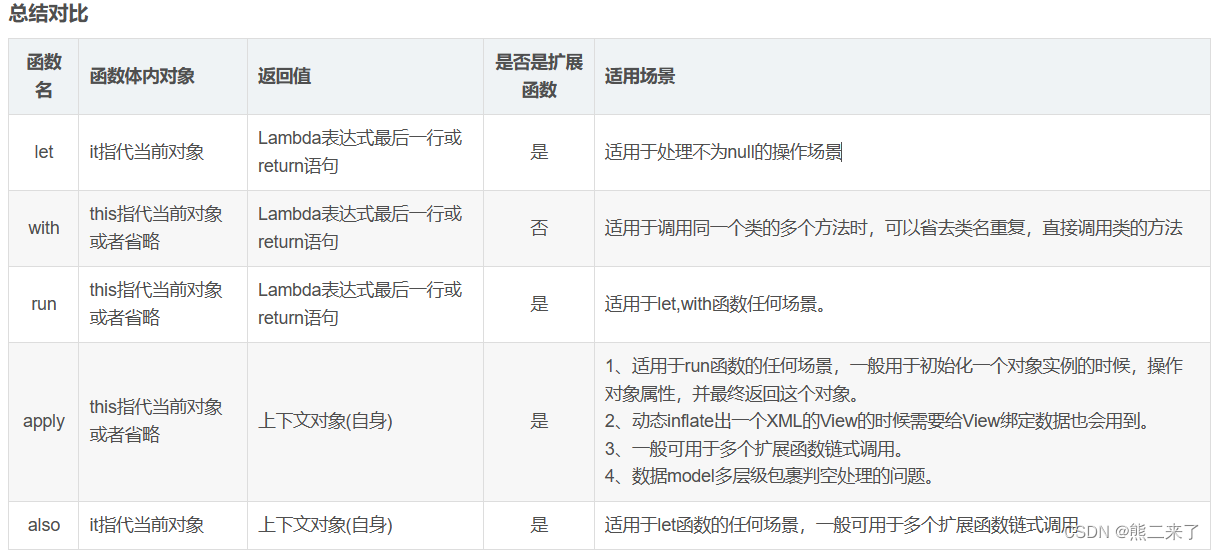
下面通过例子来说明
/**
* 本例用于演示 let, also, with, run, runCatching, apply 的用法
*/
package com.webabcd.androiddemo.kotlin
import androidx.appcompat.app.AppCompatActivity
import android.os.Bundle
import com.webabcd.androiddemo.R
import kotlinx.android.synthetic.main.activity_kotlin_helloworld.*
import java.io.IOException
class Demo12 : AppCompatActivity() {
override fun onCreate(savedInstanceState: Bundle?) {
super.onCreate(savedInstanceState)
setContentView(R.layout.activity_kotlin_demo12)
sample1() // let
sample2() // also
sample3() // with
sample4() // run, runCatching
sample5() // apply
}
fun sample1() {
val a = 1
// let 的意思就是用 it 代替 let 左侧的对象
a.let {
appendMessage("${it + 1}") // 2
}
// 当然,你可以用别的名称代替 it
a.let { p ->
appendMessage("${p + 1}") // 2
}
val b: Int? = 1
// let 的使用场景一般会结合 null 判断,即 ?.let
b?.let {
appendMessage("${it + 1}") // 2
}
// let 的最后一个表达式的值就是返回值
var c = b?.let {
appendMessage("${it + 1}") // 2
"xyz" // 这是返回值。当然,你也可以通过 return 显式的返回一个值,比如 return@let "xyz"
}
appendMessage("$c") // xyz
}
fun sample2() {
val a: Int? = 1
// also 和 let 是基本一样的,区别就是 also 的返回值就是 also 左侧的对象(这样就可以使用链式语法了)
a?.also {
appendMessage("${it + 1}") // 2
}?.also {
appendMessage("${it + 1}") // 2
}?.also {
appendMessage("${it + 1}") // 2
}
}
fun sample3() {
val a = "webabcd"
// with 的意思就是通过 this 代替你 with 的对象,如果你需要调用 this 的方法或属性,那么可以省略 this
with(a) {
appendMessage("${this.length}, $length") // 7, 7
}
// with 的最后一个表达式的值就是返回值
val b = with(a) {
appendMessage("${this.length}, $length") // 7, 7
"xyz" // 这是返回值。当然,你也可以通过 return 显式的返回一个值,比如 return@with "xyz"
}
appendMessage("$b") // xyz
}
fun sample4() {
val a: String? = "webabcd"
// run 是 let 和 with 的结合体,最后一个表达式的值就是返回值
val b = a?.run {
appendMessage("$length") // 7
"xyz" // 这是返回值。当然,你也可以通过 return 显式的返回一个值,比如 return@run "xyz"
}
appendMessage("$b") // xyz
// runCatching 就是 run 和 try/catch/finally 的结合体
val c = a?.runCatching {
throw Exception("I am an Exception")
}?.onSuccess {
appendMessage("onSuccess")
}?.onFailure {
appendMessage("onFailure: $it") // onFailure: java.lang.Exception: I am an Exception
}
// 获取返回值,有异常则返回 null
appendMessage("${c?.getOrNull()}") // null
val d = a!!.runCatching {
"xyz" // 最后一个表达式的值就是返回值。当然,你也可以通过 return 显式的返回一个值,比如 return@runCatching "xyz"
}.onSuccess {
appendMessage("onSuccess") // onSuccess
}.onFailure {
appendMessage("onFailure: $it")
}
// 获取返回值,有异常则返回 null
appendMessage("${d.getOrNull()}") // xyz
}
fun sample5() {
val a: String? = "webabcd"
// apply 是 also 和 with 的结合体,返回值就是 apply 左侧的对象(这样就可以使用链式语法了)
a?.apply {
appendMessage("$length") // 7
}?.apply {
appendMessage("$length") // 7
}?.apply {
appendMessage("$length") // 7
}
}
fun appendMessage(message: String) {
textView1.append(message)
textView1.append("\n")
}
}






















 被折叠的 条评论
为什么被折叠?
被折叠的 条评论
为什么被折叠?








